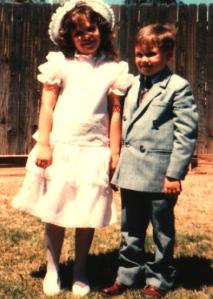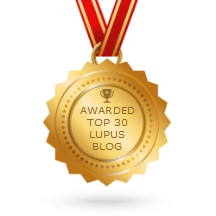More lupus facts, melodies and familial autoimmune maladies
Familial Autoimmunity
This original post was written once on Saturday May 18th, but went into the netherworld of glitches in cyberspace. Today, I am reviving that attempt. The day I started this post would have been my mother’s 80th birthday, and remembering her prompted me to take a very special look at our familial autoimmunity.
Over just four generations, my family has many autoimmune examples including lupus, rheumatoid arthritis, gout, psoriasis, thyroid disease, diabetes, severe allergies and asthma. All month-long we had thus far been spotlighting various lupus bloggers, but this post is different. Long over the intense grief that followed the loss of my mom, now she is remembered with twinges of recurring lament over her failure to survive a massive stroke at 65.
My mother was part of an autoimmune heritage that began with her mother, and extends through four generations through me to my daughter.
Happily, our four generations also share a deep love of music, also passed down from mother to daughter like a beautiful melody unrelated to our shared autoimmunity. This post is about melodies and autoimmune maladies.
Grandma with RA
Warming hands in soapy water
My grandmother Bonnie had rheumatoid arthritis. My mother remembered her mother arising each morning with aching, swollen, stiff hands. Grandma would walk over to the kitchen sink and massage her hands in the dish pan’s warm soapy water, while her painful hands were soothed by its penetrating comfort. Then, she would grab a kitchen towel to dry her hands, and then neatly fold and set it back on the kitchen counter.
Next, on most mornings, grandma would go to the piano in their old-fashioned parlor and sit down to play. My mother followed her, watching, but sometime was still sleeping at this hour and woke to the strains of music wafting through the house. Although it was equipped as a player piano, grandma played it herself every morning without running the player scroll. Grandma explained to her that it felt better in the long run if she made her painful hands gently play the piano, so they could become stronger and more able to fight the arthritis that tried to cripple them.
Playing piano in the mornings
My mother explained that my grandmother took quinine every day for her rheumatoid arthritis. By the end of her life,my grandmother was diabetic and blind, perhaps from the diabetes, or from her cataracts from a lifetime of steroids, or perhaps from collection of quinine on her retina. Quinine is the drug from which modern-day Plaquenil is derived.
Oranges, quinine and grandma
I cannot break into a fresh orange without remembering my mother tell me about the quinine in its peel, and how good quinine was for me. It was often in this context she would mention her mother’s RA. We never knew what actually caused my grandmother’s late-life sight loss, but she lived to the age of 83, finally succumbing to complications of her diabetes.
Mom with Gout
Mom and her gout
My mother never showed any signs of RA, but she did suffer from gout, another form of autoimmune arthritis. Her gout came and went in occasional flares and episodes. When uric acid levels built up too high in her blood, she eventually suffered pain when it began to spill over from her blood into her swollen, red finger and toe joints as painful uric acid crystals.
My mother described the intense pain and we could see the obvious redness, distortion and swelling of her joints. Gout only bothered her acutely a few times, because with the diagnosis she learned about specific diet changes that help control uric acid build up and prevent flares, so she managed it fairly well.
Mom watched and learned
As a little girl, my mother liked to watch and listen to grandma play the piano, and eventually learned to play a little herself. She told me about times she would enjoy sitting at the piano herself, and how she learned to change the songs on the player roll. Mother also loved to try to play the keys along with the automated pianist as it rolled its way through the songs. My mother grew to love music, and infected me with that love, too.
Me with Lupus
My childhood foreshadowed my adult lupus diagnosis with many signs and symptoms of this autoimmune disease. At the age of five, signs of knee and hip arthritis appeared, and by sixteen arthritis invaded my hands and fingers. Growing up, there were several episodes of discoid lupus rashes on my hands, face and neck that showed up after playing outside in the sun. My parents called the rashes a “sun allergy.” Then, there was a year of unexplained severe anemia in my early childhood, along with severe episodes with unexplained high fevers in the absence any signs of infection. Throughout childhood there were countless episodes of weeks of extreme fatigue.
All these recurring and varied signs and symptoms led my doctors to repeatedly test me for my grandmother’s autoimmune diseases: diabetes and rheumatoid arthritis. With tests always being negative, my family doctor would diagnose “unknown virus” and put me on a diabetes diet at five as a precaution. The diet was a good thing, overall, because it was a healthy balanced meal plan, very much like the Weight Watchers plan I am following today.
 My autoimmunity finally was clearly diagnosed as lupus when I was thirty-something: not surprising, considering the known familial autoimmune heritage from the two generations before me. Any earlier history of auto-immune disease in our family remains unknown, however, my sister had her thyroid removed after autoimmunity destroyed it. One of my brothers is showing signs of major arthritis, and I encouraged him just this week to discuss our familial autoimmunity with his doctor.
My autoimmunity finally was clearly diagnosed as lupus when I was thirty-something: not surprising, considering the known familial autoimmune heritage from the two generations before me. Any earlier history of auto-immune disease in our family remains unknown, however, my sister had her thyroid removed after autoimmunity destroyed it. One of my brothers is showing signs of major arthritis, and I encouraged him just this week to discuss our familial autoimmunity with his doctor.
Now, I am under a good treatment plan for my lupus, and stay active, exercise and play the piano almost every morning. Even when my joints are swollen, I try to exercise gently, do mild yoga stretches and I sit down to play music. I hope to retire from my government legal management position in a few years, and move into my second career as a music teacher. I look forward to this less stressful future occupation.
Daughter with Psoriasis
My daughter inherited the genetic autoimmune legacy and has severe psoriasis and has severe asthma. Her psoriasis is the head to toe variety that is measured in percentages of total skin involvement. She never has a time when she does not have countless plaques on arms, legs and body. Thankfully, her lovely face and contagious smile are mostly spared from its marring eruptions, although her scalp has constant aggressive flares.
In her teen years when she first developed psoriasis, its severity broke my heart. I amazes me how gracefully she bears this autoimmune burden. She plays many instruments, teaches elementary band, choir and general music. She watches and waits, ever alert for signs of psoriatic arthritis that might threaten her dexterity and ability to play the flute and other instruments that she loves.
My son has four children and the oldest has severe asthma, just like my husband and daughter. He is a young assistant pastor, church choir director and plays a little piano too. His son is learning piano, just like my husband, my grandma, my mother and me.
Lupus Facts @ Prognosis and Hope

Lupus & Normal Life Span: With current methods of therapy, 80 to 90 percent of people with non-organ threatening lupus can look forward to a normal lifespan. The 10 to 20 percent of Lupus patients with more severe lupus can expect to live a long, productive life with proper early treatment.
For more information about this lupus fact, please read my full post on this subject from last year – May 28, 2012

Pregnancy Outcomes: Advancing technology and better understanding of the disease have improved pregnancy outcomes. Today, 80 percent of women with inactive lupus can have successful pregnancies. First, it is a great idea to learn about the issues and risks of pregnancy in lupus.
For more information about this lupus fact, please read my full post on this subject from last year – May 29, 2012

Working with Lupus and Accommodation: Most people with lupus are able to continue to work. However, some may need changes to their work environment and schedules, such as flexible work hours, job-sharing, and telecommuting.
For more information about this lupus fact, please read my full post on this subject from last year – May 30, 2012
















Recent Comments